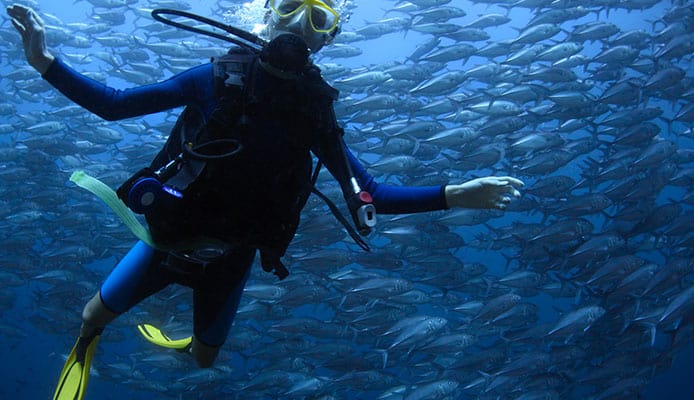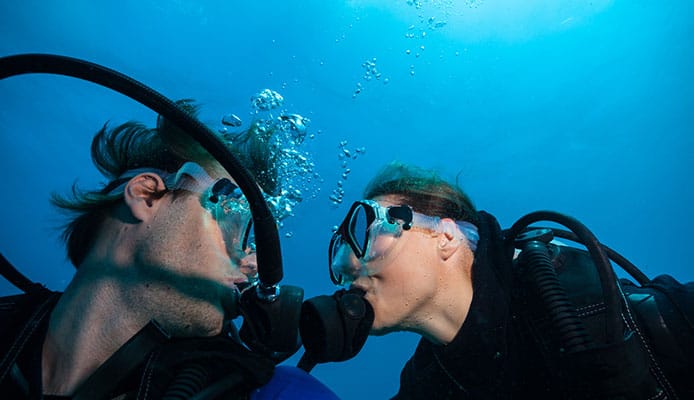
There are many different types of scuba regulators available in the market. The importance of the diving regulator cannot be overstated as it is one of the crucial pieces of gear that any diver will need to be able to breathe underwater.
However, regardless of the type of dive regulator that you choose, they all come with three major parts and that is the 1ststage, the 2nd stage, and the regulator air hose.
1st stage and 2nd stage
The 1st stage of the diving regulator is the part that connects to the scuba tank. This is via a DIN setting or a yoke. Its function is to regulate the pressure of the air leaving the tank before it can get into the hose. The 2nd stage of the diving regulator is the one that connects to the mouthpiece as well as the purge valve.
The 2nd stage has two main factions. One is to remove any particles or waste from the diver’s mouth as well as to deliver the air through the mouth.
Diaphragm and Piston
There are two main ways that a regulator works. It can either use a diaphragm or a piston. Their functions are to regulate the pressure of the air as it leaves the scuba tank in the 1ststage and brings it down to moderate pressure. Keep this in mind when checking out the 10 best dive sites in brazil.
Both types of scuba regulators are effective at controlling pressure as per the requirements of the diver. However, if you require a higher flow, then the piston regulator is more effective than the diaphragm regulator.
Thanks to the fact that piston regulators only have a single moving part, they tend to have better airflow. This also makes them more precise than the diaphragm regulator. Because of this, they are much more expensive than their diaphragm counterparts.
The less moving parts also mean easier maintenance and fewer chances of something going wrong. As for the diaphragm regulators, they are easier to manufacture even with their many moving parts. If you plan on recreational diving then you will never notice the difference in performance between the two types of scuba regulators.
Coldwater diving however is better suited for diaphragm regulators than piston scuba regulators as the diaphragm has lower chances of free-flowing. Also, make sure you have the best wetsuit.
Exhaust Valve or Purge Button
The exhaust valve is found on the 2nd stage and allows the diver to exhale and release air into the water. This is therefore a one-way valve. It is where you see bubbles exiting the mouthpiece.
One major benefit of the purge button is that it makes it possible for the diver to force air from his scuba tank. This blows out water that may have gotten into the 2nd stage. The great thing is that the button is simple to use and you will be able to manipulate it even if you are wearing thick dive gloves.
In fact, all you need is one finger to perform the purge and you are all set.
Din vs Yoke
The two main types of fittings that are used to connect the 1st stage to the scuba tank are either the DIN or the yoke. The more common of the two is the yoke coupling fitting and is mostly found with aluminum 80 tanks.
On the other hand, are DIN fittings. These are believed to be much safer than the yoke fittings and are best for high-pressure tanks. Their main benefit is that they use a screw mechanism to connect to the tank. They will also trap the O ring that is designed for high pressure thereby preventing it from protruding.
This can happen occasionally when you are using the yoke style fitting.
However, note that a DIN scuba regulator can also be fitted with a yoke adaptor. This will screw onto the part of the DIN fitting that is threaded. For yoke-type scuba tanks, however, this type of adaptor can be cumbersome.
These methods apply even while using special gas mixtures. If you are contemplating on a different type of gas, check out what is trimix diving.
On the other hand, it is possible for a yoke regulator to also be fitted with a DIN adaptor. This will replace the yoke part on the 1stsage. However, it will only be temporary. Always ensure that you do not perform the DIN adaptor installation on your own but instead seek the services of a qualified scuba diving gear packages technician.
Balanced Regulators
The main feature with the balanced regulators is that they allow for steady breathing and this is regardless of how deep you are or the amount of pressure on the tank. Only in the rarest cases do divers choose unbalanced regulators.
An unbalanced regulator tends to make you feel like you do not have full control of your breathing. This is especially so when you are diving down where the increase in pressure causes the air to compress and diminish.
With balanced scuba regulators, you can maintain comfortable breathing throughout the dive regardless of the depth or pressure. If you are planning on checking out the 10 best dive sites in Belize, you might want to use a balanced regulator. The main downside with these regulators is that they are a bit more technical and complicated than the unbalanced regulators. This also makes them more expensive than the unbalanced regulators.
With the balanced regulators, however, you can compensate for the depth by allowing the diver to decrease the pressure on the tank by releasing air through both sides of the air valve.
You might also like: How Long Does A Scuba Tank Last?
The Mouthpiece
Perhaps something worth noting is the 2nd stage mouthpiece and how important it is. It should feel comfortable when in your mouth. If you are trying out your gear and the mouthpiece feels too small or too big, you should change it to a size that you are comfortable with to dive down. Take a look at the 5 points to descend guide.
Globo Surf Overview
When buying your own dive regulator, you will have plenty of different options to choose from. By understanding the different types of scuba regulators, you can make the best and most ideal choice for your diving. As you do so, always go for the highest quality regulator that you can find or afford.


